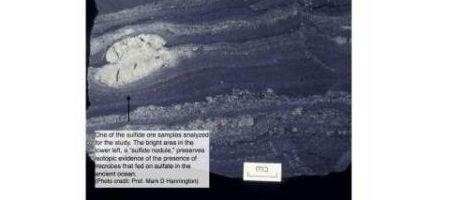Microbes were munching on sulfate in the ocean as long as 2.7 billion years ago, influencing seawater chemistry.

According to a team of Canadian and US scientists, an analysis of sulfide ore deposits from one of the world’s richest base-metal mines is casting new light on the early evolution of life.
Sulfate is the second most abundant dissolved ion in the oceans today, and comes from the ‘rusting’ of rocks by atmospheric oxygen. Using a a mass spectrometer, the team measured the weight of sulfur in samples from the Kidd Creek copper-zinc mine in Timmins, Ontario, and found that much less was incorporated into the 2.7 billion-year-old ore than today.
But although they conclude that sulfate levels were about 350 times lower than in today’s ocean, the sulfate still supported an active global population of microbes. The microbes used sulfate to gain energy from organic carbon.
“Deep within a copper-zinc mine in northern Ontario that was once a volcanically active ancient seafloor may not be the most intuitive place one would think to look for clues into the conditions in which the earliest microbes thrived over 2.7 billion years ago,” says PhD student John Jamieson of the University of Ottawa.
“However, our increasing understanding of these ancient environments and our abilities to analyze samples to a very high precision has opened the door to further our understanding of the conditions under which life evolved.”
Such sulfide ore deposits are widespread, with most found in Canada and Quebec.
“We now have a tool for probing when and where these microbes actually came into global prominence,” says Professor Boswell Wing, an associate professor in McGill’s Department of Earth and Planetary Science.






